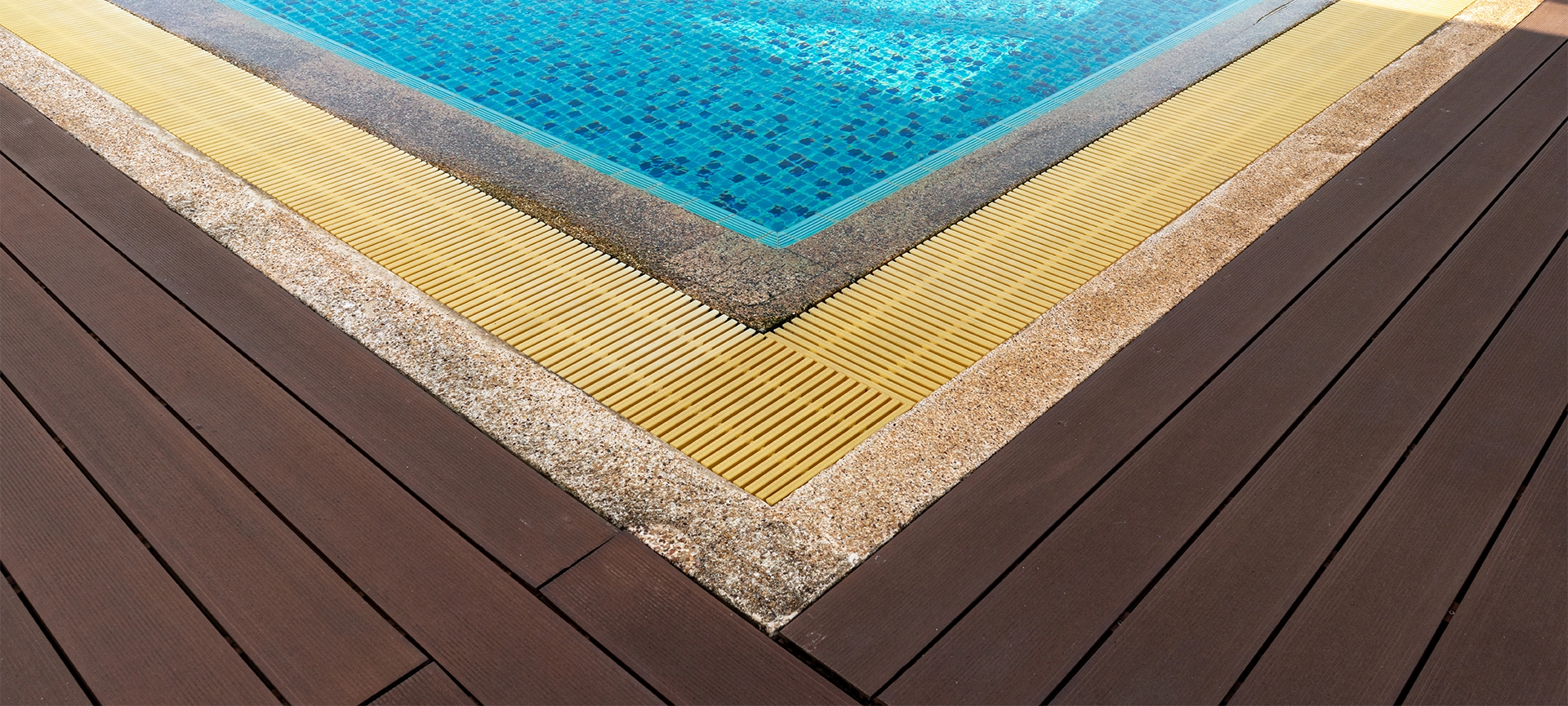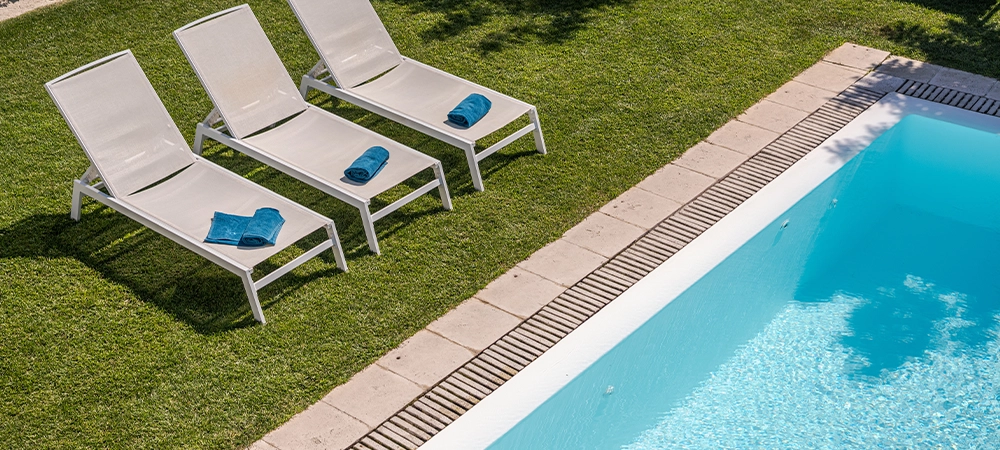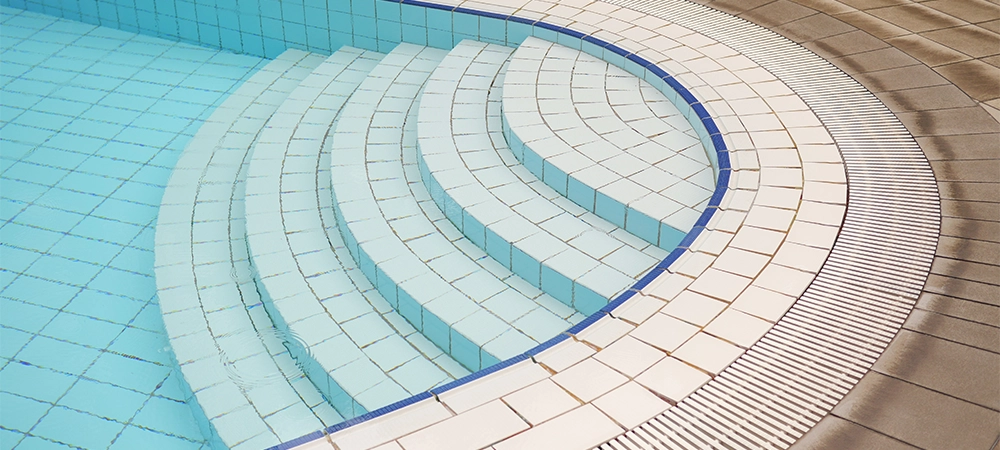Do Pool Copings Crack in Cold Weather?

Pool coping is more than a decorative border. It’s the protective edge that separates the pool shell from the surrounding deck, helping to direct water away and prevent damage. Without it, water would seep behind the pool walls, weakening the structure and leading to costly repairs.
Coping also gives pools their finished look. It frames the design, hides concrete edges, and provides a safe, non-slip surface for swimmers to walk or sit on. Whether made from natural stone, poured concrete, or interlocking pavers, coping has both functional and visual importance, especially in Canada’s variable climate.
Related Article: When Is the Best Time to Install a Pool Cover?
Why Cold Weather Causes Cracks
Toronto homeowners know how harsh winters can be. When temperatures swing between freezing and thawing, moisture becomes the main culprit behind coping cracks.
Water seeps into small pores or joints in the material. Once it freezes, it expands, putting pressure on the coping and causing cracks or separation.
This cycle repeats several times during a typical Ontario winter. Even the strongest materials, if not properly sealed or installed, can eventually weaken. The freeze–thaw effect is especially damaging when:
- The coping material is highly porous.
- Drainage is inadequate, allowing water to pool.
- The sealant has worn off or was never applied.
- There are existing micro-cracks or gaps in mortar joints.
Over time, these small fractures expand, compromising both aesthetics and safety. A cracked coping edge can chip further, making it unsafe for anyone walking around the pool perimeter.
Related Article: Common Pool Issues and How We Fix Them For You
Common Causes of Cracking Beyond Weather
While freezing temperatures are the leading cause, several other factors can accelerate damage:
- Poor Installation Practices: Inadequate bedding, improper mortar mix, or failure to include expansion joints all reduce flexibility and resistance against thermal stress.
- Weak Adhesion or Materials: Using cheap or incorrect bonding agents can cause coping stones to lift or separate when exposed to temperature shifts.
- Ground Movement (Frost Heave): As the ground freezes, it expands. This upward pressure can push coping stones out of place or crack the mortar bed beneath them.
- Improper Drainage Around the Pool: Standing water magnifies freeze–thaw damage. A well-graded pool deck with adequate runoff helps reduce this risk.
- Natural Wear and Tear: Even well-built coping has a lifespan. After several years of exposure to chemicals, UV rays, and weather cycles, minor cracks can develop naturally.

Best Coping Materials for Cold Climates
Not all materials perform equally under freezing conditions. Choosing the right one can greatly reduce cracking and maintenance costs.
| Material | Cold-Weather Performance | Maintenance Level | Aesthetic Appeal |
|---|---|---|---|
| Granite or Bluestone | Excellent resistance to frost and minimal porosity. | Low | Natural, elegant finish |
| Concrete Pavers | Moderate; durable if sealed annually. | Medium | Wide colour and shape variety |
| Limestone or Sandstone | Fair; porous and prone to freeze damage unless sealed well. | High | Warm, traditional look |
| Brick Coping | Good; handles expansion but needs regular sealing. | Medium | Classic poolside charm |
| Composite or Manufactured Stone | Excellent; engineered for freeze–thaw cycles. | Low | Modern, uniform appearance |
For GTA homeowners, dense natural stones like granite or engineered pavers are often the best options for long-term performance and minimal cracking.
How to Prevent Pool Coping from Cracking
Winter damage can be minimized with proactive care. Here’s how:
- Apply a Quality Sealant
Before winter arrives, seal coping surfaces and joints to block moisture infiltration. Reapply every one to two years for optimal protection. - Ensure Proper Drainage
The deck surrounding your pool should slope slightly away from the waterline. Clean weep holes and drains before freezing weather starts. - Winterize the Pool Correctly
Lower water levels below the coping edge, remove ladders and skimmers, and use a fitted cover to prevent snowmelt from accumulating at the rim. - Repair Early, Not Later
Address small cracks or gaps in the spring. A minor repair today prevents a major replacement next season. - Avoid Salt Exposure
If your pool uses a saltwater system, rinse the coping regularly. Salt can degrade unsealed concrete and natural stone faster in cold conditions. - Schedule Professional Inspections
Before each winter, have experts check your coping, tiles, and deck joints. They can identify hidden weak points before damage spreads.
Related Article: Signs It’s Time to Restore or Renovate Your Pool
How Green Side Up Ensures Long-Lasting Pool Coping
Proper pool planning and construction is the foundation of durability; this includes the pool coping. At Green Side Up Contracting, every project in the Greater Toronto Area follows strict standards to handle Ontario’s freeze–thaw conditions.
Our team uses frost-resistant mortar, control joints, and non-slip finishes to maintain stability and safety. Each coping stone is laid on a compacted base and bonded with high-grade adhesives designed for cold-weather movement.
We also integrate coping work seamlessly with the rest of your landscape, whether you’re adding a new deck, patio, or retaining wall, creating an outdoor space that’s both cohesive and resilient.
If your existing pool coping is showing signs of wear, our professional pool builders can repair or replace damaged sections without tearing out the entire border. This approach saves homeowners time and cost while restoring safety and appearance.
Seasonal Maintenance Checklist
A seasonal checklist helps homeowners stay ahead of potential damage. Here’s what to include:
Before Winter:
- Clean coping surfaces and remove debris.
- Reseal coping if it hasn’t been done in 12 months.
- Inspect expansion joints for cracks.
- Cover the pool securely to prevent ice buildup.
After Winter:
- Check coping for chips or separation.
- Pressure wash gently to remove salt or residue.
- Reseal if the surface looks dull or porous.
- Re-level or reset any loose stones.
Maintaining this schedule each year helps prevent cumulative freeze–thaw damage and keeps your pool area safe and attractive.

Repair or Replace: How to Decide
Sometimes, even with the best care, cracks appear. The decision to repair or replace depends on the extent of damage:
- Hairline Cracks: Can often be filled with a flexible epoxy or polymer-based sealant.
- Separated Joints: Re-bond using fresh mortar or adhesive.
- Multiple Cracks or Shifting: Usually indicates a deeper structural issue, requiring partial replacement.
- Severe Frost Heave: May need excavation and reinstallation with frost-proof bedding layers.
Green Side Up’s specialists assess each situation individually, ensuring homeowners only pay for what’s necessary—no more, no less.
A Smart Investment for Every Homeowner
Beyond aesthetics, quality coping protects your pool’s structure, helps maintain resale value, and enhances the comfort of your outdoor space. In climates like Toronto’s, where winters test every outdoor material, cutting corners on coping installation or maintenance can lead to higher costs later.
Working with an experienced contractor ensures that your pool and the surrounding landscape stand up beautifully to Canada’s seasons year after year.
Ready to Protect Your Pool Before Winter?
Cold weather is tough on outdoor structures, but with proper materials and care, your pool doesn’t have to suffer.
Call Green Side Up Contracting today for a professional pool coping inspection or repair in the GTA and York Region.
Frequently Asked Questions
Can freezing cause tiles to pop off, too?
Yes. The same freeze–thaw pressure that cracks coping can loosen waterline tiles if the adhesive isn’t frost-resistant.
How can I tell if my coping needs replacement?
If multiple sections are loose, uneven, or show wide cracks, it’s safer to replace the affected area than to patch repeatedly.
What’s the best time of year to reseal pool coping?
Late spring or early fall, when temperatures are moderate and surfaces are dry, is ideal for sealing.
Is it worth upgrading to frost-resistant coping?
Absolutely. Frost-resistant materials like granite or composite pavers significantly reduce long-term maintenance costs.
How long does professionally installed coping last?
With proper care and sealing, high-quality coping can last 15–25 years even in Ontario’s cold climate.
Can cracked coping affect my pool liner or concrete shell?
Yes. Water intrusion from cracks can erode or stain the liner and damage the concrete shell over time.
Does Green Side Up repair existing coping or only install new ones?
Both. They offer inspection, repair, and replacement services for all types of coping, ensuring consistent quality and finish.
